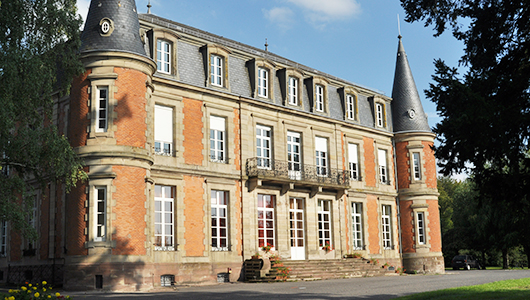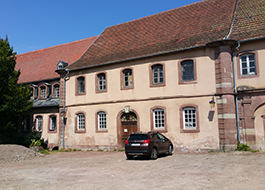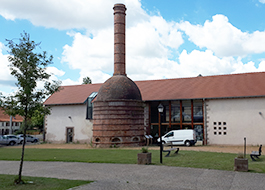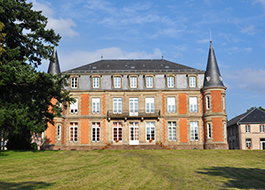Niderviller
Durée visite : 30 minutes
Moyen : Pédestre
L’origine du nom de la commune vient de l’adjectif germanique nieder « d’en bas » + weiler « le village » le village d’en bas. Niderviller faisait à l’origine partie du duché de Lorraine. Il fut cédé à la France en 1661 avec les autres localités de la prévôté de Sarrebourg. Il y avait autrefois un château seigneurial qui appartenait au général de Custine. Ce dernier est né le 4 février 1742 à Metz et guillotiné le 28 août 1793 à Paris. Député de la noblesse de Metz aux États généraux de 1789, il vote souvent avec la noblesse libérale de La Fayette, et fait partie des premiers à se rallier au Tiers-état. A-P Custine acquiert la seigneurie de Niderviller en 1770, avec la faïencerie. Il y poursuit l’œuvre de son prédécesseur, Jean-Louis Beyerlé jusqu’à sa mort. Astolphe de Custine, auteur d’un livre-somme sur la Russie, est né à Niderviller en 1790.
The origin of the name of the town comes from the Germanic adjective nieder “from below” + weiler “the village” the village from below. Niderviller was originally part of the Duchy of Lorraine. It was ceded to France in 1661 with the other localities of the provost of Sarrebourg. There was once a stately castle that belonged to General de Custine. The latter was born on February 4, 1742 in Metz and guillotined on August 28, 1793 in Paris. Deputy of the nobility of Metz in the Estates General of 1789, he often votes with the liberal nobility of La Fayette, and is one of the first to join the Third Estate. A-P Custine acquired the seigneury of Niderviller in 1770, with the earthenware factory. There he continued the work of his predecessor, Jean-Louis Beyerlé until his death.
Der Ursprung des Stadtnamens stammt aus dem germanischen Adjektiv nieder « von unten » + weiler « das Dorf » das Dorf von unten. Niderviller war ursprünglich Teil des Herzogtums Lothringen. Es wurde 1661 mit den anderen Orten des Provost von Sarrebourg an Frankreich abgetreten. Es gab einmal eine stattliche Burg, die General de Custine gehörte. Letzterer wurde am 4. Februar 1742 in Metz geboren und am 28. August 1793 in Paris guillotiniert. Als Stellvertreter des Adels von Metz in den Generalständen von 1789 stimmt er häufig mit dem liberalen Adel von La Fayette ab und ist einer der ersten, der sich dem Dritten Stand anschließt. A-P Custine erwarb 1770 mit der Steingutfabrik das Seigneury von Niderviller. Dort setzte er die Arbeit seines Vorgängers Jean-Louis Beyerlé bis zu seinem Tod fort.

Ecartelé aux 1 et 4 d’argent à la bande coticée de sable et aux 2 et 3 de sable semé de fleurs de lys d’argent ; sur le tout une croix de Lorraine de gueules accostée des lettres N et V du même.
Ce sont les armes de la famille de Custines, qui possédait la seigneurie au XVIIIe siècle et a fondé la faïencerie. La croix de Lorraine accostée des lettes N et V constituent la marque de cette célèbre faïencerie.
Quarterly 1 and 4 Argent a bend coticée Sable and 2 and 3 Sable sewn with fleur-de-lys Argent; over the whole a cross of Lorraine Gules accosted with the letters N and V of the same.
These are the arms of the Custines family, who owned the seigniory in the 18th century and founded the earthenware factory. The cross of Lorraine accosted by the letters N and V constitute the mark of this famous pottery.
Vierteljährlich 1 und 4 Argent a bend coticée Sable und 2 und 3 Sable genäht mit Fleur-de-lys Argent; über dem Ganzen ein Kreuz von Lorraine Gules, das mit den Buchstaben N und V desselben angesprochen wird.
Dies sind die Wappen der Familie Custines, die die Herrschaft im 18. Jahrhundert besaß und die Steingutfabrik gründete. Das lothringische Kreuz mit den Buchstaben N und V ist das Markenzeichen dieser berühmten Keramik.

Les habitants et les habitantes de Niderviller s’appellent les Nidervillois et les Nidervilloises
The inhabitants of Niderviller are called Nidervillois and Nidervilloises.
Die Einwohner von Niderviller heißen Nidervillois und Nidervilloises.

Les lécheurs d’assiettes
Ce terme, qui se traduit habituellement, au figuré, par pique – assiettes (parasite qui court les dîners) et aussi par gourmand ou gourmet, ne semble pas être applicable comme tel aux anciennes générations de ce village.
Il s’agit plutôt d’un appellatif, attribué aux habitants de Niderviller, parce qu’ils se servaient de bonne heure d’assiettes, achetées sur place à la Manufacture de porcelaine et de faience, fondée par le général de Custine, tandis qu’ailleurs dans la région, on se contentait encore de tranchoirs et d’écuelles.
Disons aussi que trois autres localités en Moselle portent le même sobriquet Fénétrange, Racrange et Wittring.
The plate lickers
This term, which is usually translated, figuratively, by pique – plates (parasite which runs the dinners) and also by gourmand or gourmet, does not seem to be applicable as such to the older generations of this village.
It is more of a name, attributed to the inhabitants of Niderviller, because they used plates from an early age, bought on the spot at the Porcelain and Faience Factory, founded by General de Custine, while Elsewhere in the region, we were still satisfied with slicers and bowls.
Let’s also say that three other localities in Moselle bear the same nickname Fénétrange, Racrange and Wittring.
Die Tellerlecker
Dieser Begriff, der üblicherweise bildlich mit Pique-Platten (Parasit, der die Abendessen leitet) und auch mit Gourmand oder Feinschmecker übersetzt wird, scheint als solcher auf die älteren Generationen dieses Dorfes nicht anwendbar zu sein.
Es ist eher ein Name, der den Einwohnern von Niderviller zugeschrieben wird, weil sie schon in jungen Jahren Teller verwendeten, die vor Ort in der von General de Custine gegründeten Porzellan- und Fayencefabrik gekauft wurden, während wir anderswo in der Region noch zufrieden waren mit Hobeln und Schüsseln.
Nehmen wir auch an, dass drei andere Orte an der Mosel den gleichen Spitznamen Fénétrange, Racrange und Wittring tragen.
Les points de visites
.
En 1762, Jean-Louis Beyerlé, seigneur de Niderviller et propriétaire de la faïencerie, fait construire l’actuel clocher, dans le style des bâtiments de cette dernière. Les vitraux du choeur, représentent respectivement la Sainte Cène et la Résurrection du Christ.
Les vitraux de la nef illustrent les scènes bibliques suivantes: du côté droit, à partir du chœur, la Nativité, Jésus en train de bénir les enfants, l’agonie de Jésus; du côté gauche, la présentation de Marie au Temple, l’Annonciation, Jésus descendu de la croix remis à sa mère. Ils ont été été réalisés, à Nancy, après les dégâts de la guerre, en 1946, dans les ateliers des « Vitraux d’Art de Lorraine », dirigés par Charles Krieger. La statue de la Vierge des Faïenciers a connu bien des pérégrinations. Son histoire vous est contée, comme celle de l’église, sur des panneaux forts bien faits.
In 1762, Jean-Louis Beyerlé, lord of Niderviller and owner of the earthenware factory, had the current bell tower built, in the style of the buildings of the latter. The stained glass windows of the choir represent respectively the Holy Supper and the Resurrection of Christ.
The windows of the nave illustrate the following biblical scenes: on the right side, from the choir, the Nativity, Jesus blessing the children, the agony of Jesus; on the left side, the presentation of Mary in the Temple, the Annunciation, Jesus taken down from the cross handed over to his mother. They were made, in Nancy, after the damage of the war, in 1946, in the workshops of the « Vitraux d’Art de Lorraine », directed by Charles Krieger. The statue of the Virgin of the Faïenciers has known many peregrinations. Its history is told to you, like that of the church, on very well-made panels.
1762 ließ Jean-Louis Beyerlé, Herr von Niderviller und Besitzer der Steingutfabrik, den heutigen Glockenturm im Stil der Gebäude der letzteren errichten. Die Buntglasfenster des Chors stellen jeweils das Heilige Abendmahl und die Auferstehung Christi dar.
Die Fenster des Kirchenschiffs zeigen folgende biblische Szenen: auf der rechten Seite, vom Chor aus, die Geburt Christi, Jesus segnet die Kinder, der Todeskampf Jesu; auf der linken Seite die Darstellung Marias im Tempel, die Verkündigung, die Übergabe Jesu vom Kreuz an seine Mutter. Sie wurden nach den Kriegsschäden 1946 in Nancy in den Werkstätten des « Vitraux d’Art de Lorraine » unter der Leitung von Charles Krieger hergestellt. Die Statue der Jungfrau von Faïenciers hat viele Wanderungen erlebt. Ihre Geschichte wird Ihnen, wie die der Kirche, auf sehr gut gemachten Tafeln erzählt.
.
.
La faïencerie de Niderviller, l’une des plus anciennes de Lorraine, est aussi la deuxième manufacture en France à avoir fabriqué également de la porcelaine. Elle fut créée à Niderviller en 1735. Tirant le meilleur parti de sa situation géographique, proche de l’Allemagne et de ses savoir-faire techniques (qu’on pense en particulier à Meissen) et influencée par les mouvements artistiques français (notamment Antoine Watteau), la finesse de ses productions la font souvent comparer à la Manufacture de Sèvres. La faïencerie est aujourd’hui une filiale du groupe Les Jolies Céramiques sans kaolin. Les céramiques de Niderviller sont exposées dans de nombreux musées à travers le monde: Musée d’anthropologie de Vancouver British Columbia, au Canada, mais aussi le Smithsonian Institution à Washington (district de Columbia), le Metropolitan Museum of Art à New York où sont exposées les statues des 4 continents.
The Niderviller earthenware factory, one of the oldest in Lorraine, is also the second factory in France to have also made porcelain. It was created in Niderviller in 1735. Making the most of its geographical location, close to Germany and its technical know-how (which we think in particular of Meissen) and influenced by French artistic movements (notably Antoine Watteau ), the finesse of its productions often make it compared to the Manufacture de Sèvres. The earthenware factory is today a subsidiary of the Les Jolies Céramiques group without kaolin. Niderviller’s ceramics are exhibited in many museums around the world: Museum of Anthropology in Vancouver British Columbia, Canada, but also the Smithsonian Institution in Washington (District of Columbia), the Metropolitan Museum of Art in New York where are exhibited statues from 4 continents.
Die Steingutfabrik Niderviller, eine der ältesten in Lothringen, ist auch die zweite Fabrik in Frankreich, in der ebenfalls Porzellan hergestellt wurde. Es wurde 1735 in Niderviller gegründet. Das Beste aus seiner geografischen Lage in der Nähe Deutschlands und seinem technischen Know-how (das wir insbesondere an Meißen denken) und dem Einfluss französischer künstlerischer Bewegungen (insbesondere Antoine Watteau) ), die Finesse seiner Produktionen machen es oft im Vergleich zur Manufacture de Sèvres. Die Steingutfabrik ist heute eine Tochtergesellschaft der Gruppe Les Jolies Céramiques ohne Kaolin. Nidervilleers Keramik wird in vielen Museen auf der ganzen Welt ausgestellt: im Museum of Anthropology in Vancouver, British Columbia, Kanada, aber auch in der Smithsonian Institution in Washington (District of Columbia) und im Metropolitan Museum of Art in New York ausgestellte Statuen aus 4 Kontinenten.
.
Cette curieuse construction est un four-bouteille. Elle doit son nom à sa forme. Ce four date de 1910. Il est du type flamme renversée. Le combustible utilisé était le bois, puis le charbon. Un four électrique l’a remplacé, lui et son jumeau, en 1953. La cuisson nécessite une température de 1200 degrés. De plus amples informations vous sont fournies sur des panneaux.
This curious construction is a bottle oven. It owes its name to its shape. This oven dates from 1910. It is of the reverse flame type. The fuel used was wood, then coal. An electric oven replaced him and his twin in 1953. Cooking requires a temperature of 1200 degrees. Further information is provided on signs.
Diese merkwürdige Konstruktion ist ein Flaschenofen. Seinen Namen verdankt er seiner Form. Dieser Ofen stammt aus dem Jahr 1910. Er ist vom Typ mit umgekehrter Flamme. Der verwendete Brennstoff war Holz, dann Kohle. Ein elektrischer Ofen ersetzte ihn und seinen Zwilling 1953. Das Kochen erfordert eine Temperatur von 1200 Grad. Weitere Informationen finden Sie auf Schildern.
.
Le 22 août 1807, Jean Pons VIDIL achète à la succession Custine deux forêts, dont l’une de 156 ha, appelée La Forêt de la Carrière. Un demi-siècle plus tard un Parisien du nom de Léopold HALPHEN, acquiert ce domaine et fait construire entre 1860 et 1863, un château dans une clairière de la forêt de Niderviller. C’est le Château des carrières! Sa fille unique épouse le propriétaire de la ferme d’Oberviller. En 1888, le Baron Von Stietencron, capitaine de la garde prussienne, achète l’ensemble du domaine. Personnage ombrageux, il tue, le 12 juillet 1901 un ouvrier italien qui avait traversé sa propriété, pour aller travailler à la conduite d’eau en construction. Il est acquitté par le conseil de guerre comme ayant agi en cas de légitime défense. Le tribunal civil de Saverne le condamne toutefois à verser une rente à la famille de la victime, mais la Cour d’appel de Colmar annule ce jugement.
On August 22, 1807, Jean Pons VIDIL bought two forests from the Custine estate, including one of 156 ha, called La Forêt de la Carrière. Half a century later a Parisian by the name of Léopold HALPHEN, acquired this estate and had a castle built between 1860 and 1863 in a clearing in the forest of Niderviller. This is the Château des Carrières! His only daughter marries the owner of the Oberviller farm. In 1888, Baron Von Stietencron, captain of the Prussian Guard, bought the entire estate. A skittish figure, on July 12, 1901, he killed an Italian worker who had crossed his property to go and work on the water pipe under construction. He was acquitted by the council of war as having acted in self-defense. The civil court of Saverne however condemns him to pay an annuity to the family of the victim, but the Court of Appeal of Colmar annuls this judgment.
Am 22. August 1807 kaufte Jean Pons VIDIL zwei Wälder vom Custine-Anwesen, darunter einen von 156 ha, La Forêt de la Carrière. Ein halbes Jahrhundert später erwarb ein Pariser namens Léopold HALPHEN dieses Anwesen und ließ zwischen 1860 und 1863 auf einer Lichtung im Wald von Niderviller eine Burg errichten. Dies ist das Château des Carrières! Seine einzige Tochter heiratet den Besitzer des Oberviller Hofes. 1888 kaufte Baron Von Stietencron, Kapitän der preußischen Garde, das gesamte Anwesen. Als scheußlicher Charakter tötete er am 12. Juli 1901 einen italienischen Arbeiter, der sein Grundstück überquert hatte, um an der im Bau befindlichen Wasserleitung zu arbeiten. Er wurde vom Kriegsrat als Selbstverteidiger freigesprochen. Das Zivilgericht von Saverne verurteilt ihn jedoch, der Familie des Opfers eine Rente zu zahlen, aber das Berufungsgericht von Colmar hebt dieses Urteil auf.









